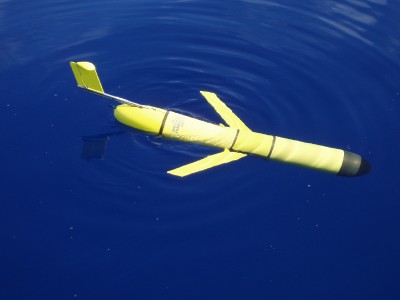
Taking a page out of a science fiction story, researchers…have successfully flown the first environmentally powered robotic vehicle through the ocean. The new robotic “glider” harvests heat energy from the ocean to propel itself across thousands of kilometers of water.
In December 2007, a research team…launched a prototype “thermal glider” off the coast of St. Thomas. The vehicle has been traveling uninterrupted ever since, crisscrossing the 4,000-meter-deep Virgin Islands Basin between St. Thomas and St Croix more than 20 times…
The new thermal glider draws its energy for propulsion from the differences in temperature—thermal stratification—between warm surface waters and colder, deeper layers of the ocean. The heat content of the ocean warms wax-filled tubes inside the engine. The expansion of the warming wax converts heat to mechanical energy, which is stored and used to push oil from a bladder inside the vehicle’s hull to one outside, changing its buoyancy. Cooling of the wax at depth completes the cycle.
“We are tapping a virtually unlimited energy source for propulsion,” said Fratantoni. The computers, radio transmitters, and other electronics on the glider are powered by alkaline batteries, which are, for now, the principal limit on the length of operation.
I love the science; but, this critter surely could scare the Bejeebus out of an unsuspecting scuba diver off the Virgin Islands.















Isn’t it a bad thing to be pulling heat from the ocean into the atmosphere? Where are all the global warming people objecting to calling this environmental?
In other global warming news,
From the The New York Times:
Almost all biofuels used today cause more greenhouse gas emissions than conventional fuels if the full emissions costs of producing these “green” fuels are taken into account, two studies being published Thursday have concluded…
Warm oceans is one of the reasons why the ice is melting on the poles.
Electric is the way to go and that energy can be produced by sources that does not emit greenhouse gases.
But don’t let this stop you from wanking in gas-guzzling your SUV.
But will it cut cables?
#3 – MarkT – But will it cut cables?
And… Will it blend?
so exactly what do you do with this thing?
Thanks, Eideard!
Much more information on gliders can be found from Scripps Institution. Larger photo of gliders, how they work, and maps of test runs.
http://spray.ucsd.edu/
“‘Spray,’ shown above, is an underwater glider developed under ONR support by Scripps and Woods Hole scientists (Sherman et al., 2001) to provide a small long-range autonomous platform for long-term ocean measurements.
#1 – two reports vs. 100’s supporting a sensible range of alternatives – and easy enough to pull apart from the viewpoint of complete market economics. Not that it would matter much to you.
Gee, one of the them even had a scientist.
A very interesting article. Using water thermals, to glide. This would be completely silent.
7: isn’t that about the same ratio (and author bio) as the “man has no impact” global warming studies?
Hmmmmm… a good little underwater spy device.
The robotic vehicle uses its propulsion to keep away from those horny little barnacles. 😉
How does it get forward thrust? I understand the up and down bit, but what make it ‘propel’ itself?
#12, MaxMars, it’s an ocean glider – it has “wings”. It moves forward in water just as an airplane or glider moves forward in the air as it loses altitude. In this case, it’s also able to move forward as it climbs when it has positive buoyancy.
Bubba–something doesn’t add up. Aircraft still need forward thrust in order to glide. If your engine quits, yes, you glide–once. No up and down and that effect would be more pronounced in water with its greater friction. Wings affect the vertical motion, not the forward motion. Course, with friction, it does all interact–but the basic say there is no glider effect after the initial static energy is used up? Now–if the thing is weighted and it sinks and then at depth a gas is created making it bouyant and that process can be repeated–then ok,but then why a battery? It may be “mostly” ocean temp driven, but not all the way?
I read a few sites and they talked about the life of the vehicle still being pegged to battery life. Still a bit vague to me.
Fit a warhead on it….silent running torpedo. Lets invade the Virgin Islands….I need the sun. Oh, thats right, we own them. What the hell, do it anyway.
I suppose if its is weighted at the nose, it could use gravity to get a bit of forward momentum…
Still it’s a cool idea.
Now about the Virgin Islands… 🙂